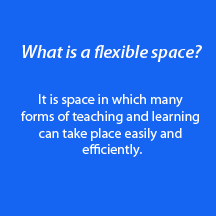Flexibility in the Classroom
by Greg Barrett, M.Ed, REFP / Educational Planner
Recently, in a professional working group, my peers and I were asked to respond to a prompt: How do teaching and learning approaches like Project Based Learning and Multiple Intelligences impact school design?
Having been a teacher and administrator before, approaches like these feel dear. Project-based learning (PBL) and Gardner’s Multiple Intelligences (MI) are a couple among hundreds of ways educators think about teaching and learning. In a well devised class, an educator likely has several strategies and theories at work concurrently.
When thinking about educational space design, finding a specific set of learning strategies to design towards can hurt in the long run. Heresy! I know, I hear you. Of course, one designs to client programmatic needs, but what if designing for an educational strategy means that other strategies are pushed to the wayside?
Instead, let’s design spaces that support a multitude of teaching and learning styles in the same environment; especially since, in the lifespan of a classroom, many varying strategies will be employed. This is long term flexibility in space, which saves future repurposing dollars.

On the micro-scale, classroom flexibility makes for more effective education space. Planning lessons, the question that dogged me most was “How can I engage all the students in my class for this content?” Some students would do better in a small group, others on their own, and others using hands-on materials to play with a new concept. How could I give everyone what they needed?
Content isn’t inflexible – there’s no shortage of tips on how to reach different learners; often, one of the biggest constraints to those targeted activities is how easily they can be done in a classroom. Is it possible to quickly and without tears get a group of 1st graders to change the layout of the space? These transitions are crucial in a classroom and made easier with flexible furniture and a space that supports different set-ups.
There are innumerable ways of learning and teaching, and they all walk into a school as students and teachers.
Why do we need that? Wasn’t it simpler in the days of the one room school house where a strict teacher just told every quiet student what they needed to know? Well, as mentioned before, there are innumerable ways of learning and teaching and, like it or not, they all walk into a school as students and teachers. The job is therefore complex, and the space must be able to support the varying answers that our education practitioners come up with to produce student achievement.
As designers, we shouldn’t recoil from this truth, nor from supporting the varying possibilities in the educational spaces we design. Instead, we need to make learning spaces a good place for teachers to teach and students to learn by allowing the many possible teaching and learning solutions in the schools we design. ♦

